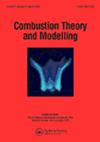氢气添加对贫预混层流甲烷火焰在应变和热损失联合作用下消耗速度的影响
IF 1.9
4区 工程技术
Q4 ENERGY & FUELS
引用次数: 1
摘要
本研究对氢气添加对暴露于应变和热损失组合下的预混贫甲烷-空气层流火焰消耗速度的影响进行了数值分析。0.9、0.7和0.5的当量比,燃料混合物成分从纯甲烷到纯氢气,被认为涵盖了贫区的广泛条件。产品侧有热损失的一维不对称逆流预混层流火焰(aCFPF)被视为代表湍流火焰基本单元的小火焰配置,消耗速度用于表征应变和热损失的影响。由于多组分混合物消耗速度的定义不明确,因此对两种定义进行了比较。第一个定义基于燃料种类的消耗率的加权组合,第二个定义基于全局热释放率。与基于燃料消耗的定义相比,基于热释放的消耗速度的定义导致一些甲烷-氢气-空气混合物的拉伸火焰速度的值更低,甚至对应变率的响应相反。应变速率导致贫甲烷-氢气混合物的火焰速度增加,达到最大值,之后火焰速度随着应变速率而降低。热损失降低了拉伸火焰的速度,并由于应变和热损失的结合而导致小火焰更快地熄灭。氢气添加量和当量比显著影响最大消耗速度和火焰对组合应变速率和热损失的响应。还分析了氢气对混合物热扩散性能的影响,其特征为Zeldovich数和有效Lewis数,并与对消耗速度的影响有关。根据aCFPF的结果,对多组分燃料混合物的路易斯数的两个定义进行了评估。本文章由计算机程序翻译,如有差异,请以英文原文为准。
Effect of hydrogen addition on the consumption speed of lean premixed laminar methane flames exposed to combined strain and heat loss
This study presents a numerical analysis of the impact of hydrogen addition on the consumption speed of premixed lean methane-air laminar flames exposed to combined strain and heat loss. Equivalence ratios of 0.9, 0.7, and 0.5 with fuel mixture composition ranging from pure methane to pure hydrogen are considered to cover a wide range of conditions in the lean region. The 1-D asymmetric counter-flow premixed laminar flame (aCFPF) with heat loss on the product side is considered as a flamelet configuration that represents an elementary unit of a turbulent flame and the consumption speed is used to characterise the effect of strain and heat loss. Due to the ambiguity in the definition of the consumption speed of multi-component mixtures, two definitions are compared. The first definition is based on a weighted combination of the consumption rate of the fuel species and the second one is based in the global heat release rate. The definition of the consumption speed based on the heat release results in lower values of the stretched flame speed and even an opposite response to strain rate for some methane-hydrogen-air mixtures compared to the definition based on the fuel consumption. Strain rate leads to an increase of the flame speed for the lean methane-hydrogen mixtures, reaching a maximum value after which the flame speed decreases with strain rate. Heat loss decreases the stretched flame speed and leads to a sooner extinction of the flamelet due to combined strain and heat loss. Hydrogen addition and equivalence ratio significantly impact the maximum consumption speed and the flame response to combined strain rate and heat loss. The effect of hydrogen on the thermo-diffusive properties of the mixture, characterised by the Zeldovich number and the effective Lewis number, are also analyzed and related to the effect on the consumption speed. Two definitions of the Lewis number of the multi-component fuel mixture are evaluated against the results from the aCFPF.
求助全文
通过发布文献求助,成功后即可免费获取论文全文。
去求助
来源期刊

Combustion Theory and Modelling
工程技术-工程:化工
CiteScore
3.00
自引率
7.70%
发文量
38
审稿时长
6 months
期刊介绍:
Combustion Theory and Modelling is a leading international journal devoted to the application of mathematical modelling, numerical simulation and experimental techniques to the study of combustion. Articles can cover a wide range of topics, such as: premixed laminar flames, laminar diffusion flames, turbulent combustion, fires, chemical kinetics, pollutant formation, microgravity, materials synthesis, chemical vapour deposition, catalysis, droplet and spray combustion, detonation dynamics, thermal explosions, ignition, energetic materials and propellants, burners and engine combustion. A diverse spectrum of mathematical methods may also be used, including large scale numerical simulation, hybrid computational schemes, front tracking, adaptive mesh refinement, optimized parallel computation, asymptotic methods and singular perturbation techniques, bifurcation theory, optimization methods, dynamical systems theory, cellular automata and discrete methods and probabilistic and statistical methods. Experimental studies that employ intrusive or nonintrusive diagnostics and are published in the Journal should be closely related to theoretical issues, by highlighting fundamental theoretical questions or by providing a sound basis for comparison with theory.
 求助内容:
求助内容: 应助结果提醒方式:
应助结果提醒方式:


